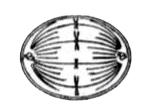The developing embryo Is a hollow sphere of cells, one cell thick during the ____ stage
cleavage
polar body
gastrula
blastula.
The correct Answer is:D
To solve the question regarding the stage of the developing embryo that is a hollow sphere of cells, one cell thick, we can follow these steps:
1. Understanding the Stages of Embryonic Development:
- The early stages of embryonic development include cleavage, morula, blastula, and gastrula.
- Each stage has distinct characteristics and structures.
2. Identifying the Cleavage Stage:
- The cleavage stage involves the division of the zygote into smaller cells called blastomeres.
- During this stage, the cells are not yet organized into a hollow structure; hence, this option is incorrect.
3. Considering the Polar Body:
- Polar bodies are byproducts of oocyte division and do not contribute to the structure of the embryo.
- They provide nutrition to the developing egg but do not form a hollow sphere of cells. Thus, this option is also incorrect.
4. Examining the Gastrula Stage:
- The gastrula stage is characterized by the formation of germ layers (ectoderm, endoderm, and mesoderm).
- At this stage, the embryo is no longer a hollow sphere but has differentiated layers, making this option incorrect as well.
5. Identifying the Blastula Stage:
- The blastula stage follows the morula stage and is characterized by a hollow sphere of cells, one cell thick.
- This structure is known as the blastocyst in mammals, and it is indeed the correct answer to the question.
6. Conclusion:
- The developing embryo is a hollow sphere of cells, one cell thick during the blastula stage.
Final Answer:
The correct answer is blastula.
- The early stages of embryonic development include cleavage, morula, blastula, and gastrula.
- Each stage has distinct characteristics and structures.
- The cleavage stage involves the division of the zygote into smaller cells called blastomeres.
- During this stage, the cells are not yet organized into a hollow structure; hence, this option is incorrect.
- Polar bodies are byproducts of oocyte division and do not contribute to the structure of the embryo.
- They provide nutrition to the developing egg but do not form a hollow sphere of cells. Thus, this option is also incorrect.
- The gastrula stage is characterized by the formation of germ layers (ectoderm, endoderm, and mesoderm).
- At this stage, the embryo is no longer a hollow sphere but has differentiated layers, making this option incorrect as well.
- The blastula stage follows the morula stage and is characterized by a hollow sphere of cells, one cell thick.
- This structure is known as the blastocyst in mammals, and it is indeed the correct answer to the question.
- The developing embryo is a hollow sphere of cells, one cell thick during the blastula stage.
The correct answer is blastula.
Similar Questions
Knowledge Check
- Question 1 - Select One
Assertion : Embryogenesis is the development of embryo from the zygote.
Reason : Cell division increase the number of cells in the developing embryo.AIf both assertion and reason are true and reason is the correct explanation of assertion.BIf both assertion and reason are true but reason is not the correct explanation of assertion.CIf assertion is true but reason is false.DIf both assertion and reason are false.
The different cells of embryo sac are
View SolutionIn a developing embryo, analyse the consequences if cell divisions are not followed by cell differentiation.
View SolutionWhen embryo develops from a haploid cell of embryo sac , other than egg cell the process is known as
View SolutionThe diagram given below represents a stage during cell division
Study the same and answer the questions that follow :

Name the type of cell division that occurs during:
Replacement of old leaves by new ones.
Formation of gametesView SolutionEmbryo at 16-celled stage is called
View Solution[A]: One diploid embryo sac mother cell develops within the nucellus of the ovule.
[R]: Embryo sac mother cell divides meioti- cally and one of the cells produced becomes the haploid embryo sac.View SolutionIn the meiosis type of cell division, the centromere divides during which stage?
View Solution

